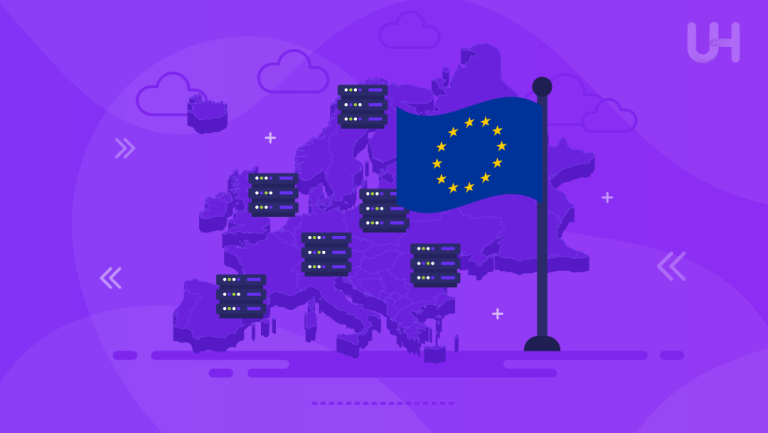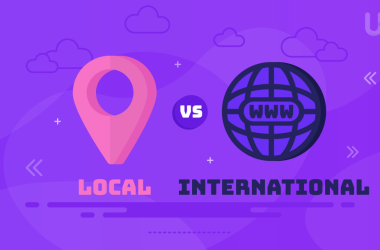A domain name is more than just an address on the internet; it is a crucial component of your online identity. A domain name helps people find your website and establishes your presence in the vast digital landscape. Selecting the right domain name can significantly impact your brand’s visibility, credibility, and accessibility. Among the many domain extensions available, the .EU domain stands out for those operating within or targeting the European Union.
Whether you’re an EU-based business looking to enhance your credibility or an individual seeking a personal web address that reflects your European identity, we will help you navigate the significance of .EU domains with ease.
What Is a .EU Domain?
A .EU domain is a top-level domain (TLD Domain) specifically designed to serve the digital needs of individuals, businesses, and organizations within the European Union. It provides a distinct online identity that signifies a connection to the EU, enhancing the regional relevance and visibility of websites that use this extension.
The .EU domain was created to promote a cohesive digital identity for the EU, fostering a sense of community among its diverse member states. By using a .EU domain with Europe VPS, businesses can emphasize their European presence, and individuals can highlight their ties to the EU, thus ensuring that their online presence aligns with their geographical and cultural identity.
Moreover, EU domain was introduced in 2005 as a result of a European Commission initiative aimed at creating a unique TLD for the European Union. This domain is managed by EURid, a non-profit organization tasked with overseeing its operations.
Eligibility Criteria
To register a .EU domain, you must meet specific eligibility criteria established by EURid. Eligible entities include individuals residing in the EU member states, Iceland, Liechtenstein, or Norway; businesses established within these regions; and public bodies or organizations operating in the EU. There are important restrictions and special considerations to keep in mind.
Registrants must provide accurate and up-to-date contact information, and non-EU residents or businesses cannot register a .EU domain unless they fulfill the residency or establishment requirements. Additionally, compliance with EU regulations and policies is mandatory for all registrants. These criteria ensure that the .EU domain remains a genuine representation of the European Union’s online community.
Benefits of Using a .EU Domain
Opting for a .EU domain offers numerous advantages. Firstly, it enhances credibility and trust, as a .EU domain signals to visitors that your website is part of the European Union’s trusted online community. This can significantly boost your domain reputation and credibility within the region.
Secondly, websites with a .EU domain benefit from improved visibility in European search engines, providing a potential boost to search engine optimization (SEO) for regional markets.
Lastly, compared to other popular TLDs like .com domain or .net domain, .EU domains tend to have better availability, increasing your chances of securing your desired domain name. These benefits make the .EU domain an attractive choice for those looking to establish a strong and credible online presence within the European Union.
Ready to Establish Your Online Presence in Europe?
Whether you’re a business looking to target European audiences effectively or establish a localized online presence, .EU domains offer a strategic advantage. Explore the power of .EU domains and kickstart your journey to digital success today!
How to Get a .EU Domain?
Choosing a Registrar
A domain registrar is a company authorized to sell and manage domain name registrations. They play a crucial role in the process of obtaining and maintaining your domain name. When selecting a registrar for your .EU domain, it’s important to consider several key criteria to ensure a smooth and reliable experience. First, look for accreditation and reputation; choose a registrar accredited by EURid, the organization responsible for managing the .EU domain.
Additionally, consider customer support quality, as responsive and knowledgeable support can help resolve issues quickly. Pricing transparency is also vital—ensure there are no hidden fees and that the registrar provides clear information on all costs involved. Lastly, evaluate the registrar’s additional services, such as Domain privacy protection, DNS management, and email hosting, to see if they meet your needs.
Registration Process
Registering a .EU domain involves several straightforward steps. First, check the availability of your desired domain name. Most registrars provide a search tool on their website where you can enter your preferred domain name to see if it is available. Once you have found an available domain, the next step is to create an account with the registrar. This typically involves providing your personal or business details, including your name, address, and contact information.
After setting up your account, you will need to provide the necessary information for the domain registration. This includes verifying your eligibility to register a .EU domain, as only residents, businesses, and organizations from the EU, Iceland, Liechtenstein, or Norway are eligible. Once you have filled out all the required information, you can proceed to complete the purchase and registration. This usually involves paying the registration fee and agreeing to the registrar’s terms and conditions. After the payment is processed, your .EU domain will be registered and you will receive confirmation from the registrar.
Managing Your .EU Domain

DNS Settings and Configurations
Once you have registered your .EU domain, managing its DNS (Domain Name System) settings and configurations is essential for ensuring your website and other online services function correctly. DNS settings translate your domain name into an IP address, directing visitors to your website.
Renewing Your Domain and Avoiding Expiration
To maintain ownership of your .EU domain, it’s important to renew it before the expiration date. Most registrars offer automatic renewal options, which can help ensure you do not accidentally let your domain expire. Typically, registrars will send renewal reminders via email as the expiration date approaches. You can renew your domain for multiple years in advance. It offers peace of mind and protection from losing your domain due to oversight.
If a domain expires, it usually enters a grace period during which you can still renew it, although additional fees may apply. After the grace period, the domain may enter a redemption period where recovery is possible but more costly. Eventually, if not renewed, the domain will become available for public registration again, and you risk losing it permanently. To avoid these issues, keep your contact information up-to-date with your registrar and consider setting up automatic renewals.
Transferring Your Domain
At some point, you may want to transfer your .EU domain to another registrar. It is either for better pricing, improved services, or other reasons. Transferring your domain involves several steps and requires coordination between your current and new registrar. Here’s a general guide to the process:
- Unlock Your Domain: Ensure your domain is unlocked for transfer. This setting can usually be adjusted in your current registrar’s control panel.
- Obtain an Authorization Code: Request an authorization code (also known as an EPP code) from your current registrar. This code is necessary to initiate the transfer.
- Initiate the Transfer: Start the transfer process with your new registrar. You will need to provide the authorization code and verify your identity.
- Approve the Transfer: After initiating the transfer, you will receive confirmation requests from both registrars. Approve these requests to proceed with the transfer.
- Wait for Completion: The transfer process can take some time to complete. During this time, your domain should remain active and functional.
Once the transfer is complete, manage your domain settings and configurations with your new registrar. It’s a good practice to check all DNS settings post-transfer to ensure everything is correctly configured.
Managing your .EU domain effectively, including handling DNS settings, renewing on time, and transferring if needed. It ensures a stable and reliable online presence within the European Union.
Conclusion
Securing a .EU domain can significantly enhance your online presence within the European Union. Because it offers a unique and trusted digital identity. Understanding the purpose and benefits of a .EU domain to navigate the registration process and manage your domain effectively. In this guide, we have provided you with the essential knowledge to establish and maintain your .EU domain successfully.
Ready to take your online presence in Europe to the next level? Explore Ultahost’s Europe dedicated server hosting for enhanced performance and reliability.
FAQ
What does .EU stands for?
The “.EU” stands for European Union. It is a top-level domain (TLD) designated for entities, businesses, and individuals within the European Union and associated countries.
What is a .EU domain?
A .EU domain is a specific internet domain extension used to identify websites associated with the European Union. It serves as a digital badge of European identity, providing businesses and individuals with a unique and region-specific online presence.
Who can register a .EU domain?
Eligible entities for registering a .EU domain include individuals residing in the EU member states, Iceland, Liechtenstein, or Norway; businesses established within these regions; and public bodies or organizations operating in the EU. Non-EU residents or businesses cannot register a .EU domain unless they fulfill specific residency or establishment requirements.
How do I check if a .EU domain is available?
You can check the availability of a .EU domain by using the search tool provided by domain registrars. Simply enter your desired domain name into the search bar on a registrar’s website, and it will indicate whether the domain is available for registration.
How do I renew my .EU domain?
Renewing your .EU domain involves logging into your account with your domain registrar and navigating to the domain management section. Here, you should find options to renew your domain name.










